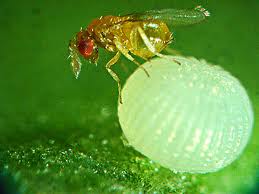Trichogramma are minute polyphagous wasps, commonly known as ‘stingless wasps’, that are endoparasitoids of insect eggs. Endoparasitoids lay their eggs in eggs or larvae of other species. Currently in the world there is an estimated 50 million animal species with 1.7 million having been described. Of these, seventy-five per cent are believed to be insects. Trichogramma represent around 80 genera from the Trichogrammatidae family with over 800 species worldwide.
Members of the Trichogrammatidae family range in size from 0.2 to 1.5 mm. Key means of dispersal include walking and short jumps. The adults require sugar as an energy source obtained from nectars, honeydew, plant sap and sugars leached through the phloem. They occur naturally in a variety of habitats across the world and have the ability to parasitize numerous host species. Their main hosts are eggs of Lepidoptera and other species such as Hymenoptera, Neuroptera, Diptera, Coleoptera and Hemiptera.
Although there are several egg parasitoids commonly used throughout the world, Trichogramma have been the most extensively studied. There have been more than a thousand papers published on Trichogramma and they are the most used biological control agents in the world. The most commonly used species for biological control are T. atopovirilia, T. brevicapillum, T. deion, T. exiguum, T. fuentesi, T. minutum, T. nubilale, T. platneri, T. pretiosum, and T. thalense.
Female adults use chemical and visual signals, such as eggs shape and colour, to locate eggs within a crop. [3] When a suitable egg is found the female will use antennal drumming to determine the size an suitability of the egg. Depending on the size and quality of the target egg, the female will drill a hold into the chorion and insert an appropriate number of eggs. A single female can parasitize one to ten eggs a day.
Trichogramma are small and very uniform in nature which causes difficulty in identifying the separate species. As females are all relatively similar it has always fallen upon the males to tell the different species apart by examining their antennae and genitalia. Currently the number of Trichogramma species is approaching 200 but previously in 1960 it was thought only six species of Trichogramma existed.
The first description of a Trichogramma species was in North America in 1871 by Charles V. Riley. He described the tiny wasps that emerged from eggs of the Viceroy butterfly as Trichogramma minutum. In entomology, original specimens are very important as they are the basis of reference for subsequent descriptions of species. The original specimens, however, were lost.
Riley also described a second species in 1879 as Trichogramma pretiosum, but these specimens were lost too. As a result, taxonomists must rely on written descriptions of these original specimens. This most likely has contributed to the difficulty in separating the morphologically similar Trichogramma genera.
To correct these errors, entomologists returned to the areas where Riley originally found the species and obtained neotype specimens of T. minutum and T. pretiosum. These specimens are now preserved properly in the United States National Museum.
Trichogramma have been used for control of lepidopteran pests for many years. They can be considered the Drosophila of the parasitoid world as they have been used for inundative releases and much of our understanding today comes from experiments with these wasps.
Entomologists in the early 1900’s began to rear Trichogramma for biological control. Trichogramma minutum is one of the most commonly found species in Europe and was first mass reared in 1926 on eggs of Sitotroga cerealella.
Nine species of Trichogramma are produced commercially in insectaries around the world with 30 countries experiencing Trichogramma released in them. Trichogramma are used for control on numerous crops and plants, these include cotton, sugarcane, vegetables, sugar beets, orchards and forests. Some of the pests that are controlled include Cotton bollworm (Helicoverpa armigera), Codling moth (Cydia pomonella), Lightbrown apple moth (Epiphyas postvittana), and European corn borer (Ostrinia nubilalis).
Trichogramma species vary in their host specificity. This can lead to non-target hosts being parasitized. This can cause problems by reducing the amount of parasitism of the target host, and depending on the rate of parasitism, non-target effects could be significant on non-target host populations. When picking Trichogramma for biological control, it is important to try to choose a host specific species and preferably a native species of Trichogramma.
Spesies
Trichogramma pretiosum is the most widely distributed Trichogramma species in North America. It has been the focus of many research studies and has been able to be reared on 18 genera of Lepidoptera. It isa more general parasitoid, by which it is likely to parasitise a range of different species. Trichogramma pretiosum (Riley) was introduced into Australia in the 1970s as part of the Ord River Irrigation Area (ORIA) IPM scheme. Trichogramma pretiosum was originally used to describe Trichogramma from hosts on non-arboreal plants such as cotton.
Trichogramma carverae are mainly used for light brown apple moth and coddling moth control and is predominately used in orchards. In Australia T. carverae is used for biological control of light brown apple moth in vineyards. Though Australia has its own native Trichogramma species there has not been much work undertaken to commercially use them for biological control within Australia. Light brown apple moth is common throughout Australia and is polyphagous on more than 80 native and introduced species. The larvae are the stage that causes the most damage, especially to grape berries which provides sites for bunch rot to occur. Losses in the crops can amount up to $2000/ ha in one season. It is very predominant in areas like the Yarra Valley. Insecticide use is not a preferred method by most growers who prefer a more natural mean of controlling pests. As a result, Trichogramma were considered a good candidate for biological control as the larvae are difficult to control with insecticide and light brown apple moths are relatively vulnerable to egg parasitism with their eggs being laid in masses of 20-50 on the upper surfaces of basal leaves in grapevines.
